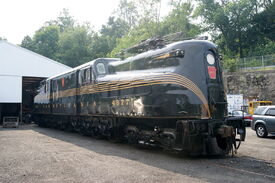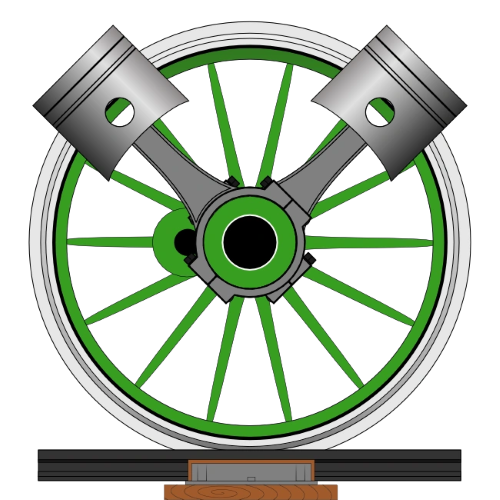
Restored GG1 electric locomotive, Pennsylvania Railroad 4877. Boonton, NJ, August 17, 2012.
Photo: Kevin Phalon.
Electric locomotives are locomotives that are completely powered by electricity. Electric locomotives can be, and often are, faster, quieter and more powerful than other types of locomotives but are less contained since they rely on connections to a power grid for energy. This often makes them more expensive to operate than diesel locomotives.
This type of locomotive is often preferred over diesel locomotives for commuter trains, because they often have better acceleration, are usually quieter, and don't produce any steam or exhaust compared to steam locomotives and diesel locomotives.
History[]
The earliest attempts at propelling locomotives with electricity date back to battery operated examples from the 1830s during the infancy of railroading. Early battery technology could not hold enough power to move "locomotives" fast, far, or for very long. The break-through came when a German inventor, Werner Von Siemens, created a very small electric locomotive. This locomotive was powered by the rails it ran on. In 1879 Siemens held an exhibition in Berlin, Germany. The locomotive was barely big enough to seat the driver, but underneath it had bunches of looped copper wires. These rubbed against the rails and picked up current.
The earliest commercial applications for electric locomotives were for metropolitan and semi-underground lines. (Full underground lines were made

An electric locomotive used Hudson's Bay Mining and Smelting Company.
possible by the electric locomotive.) One of these first commercial lines was the Baltimore and Ohio railroad (B&O), when they electrified a stretch of track which went through a long tunnel.
Mainline systems came around the turn of the century. Europe and the United States were the first to electrify. Post World War I electrified railroads (railways) had become worldwide. Australia, New Zealand, India, Indonesia, and South Africa had all electrified by 1926. Mainline electrification in the United States continued slowly but was abandoned with the advent of the diesel locomotive. Elsewhere it boomed. In countries such as Switzerland 99.6% of their railroads (railways) are electrified, the United States has less than 1% of their total railroads electrified in contrast.
Types[]
There are two main types of electric locomotive: Direct Current (DC) and Alternating Current (AC).
Catenary (overhead-wires) DC systems are normally between 1500 and 3000 Volts. Third-rail systems are much lower at 600-750 volts. While the DC traction motor is well suited to locomotive haulage, the DC system needs sub-stations (large power-boosters) placed at regular intervals along the lines.
The AC system uses a higher voltage than the DC system; 10,000 volts and above. This means that fewer sub-stations need to be used. Some AC traction-motors can even cope with using 50-60 Hertz (cycles per second) current. This means they can run on the domestic grid, albeit with the voltage far boosted.
Gallery[]
References[]
- "Locomotive." Encyclopædia Britannica Deluxe Edition 2010.
- Beginner's Knowledge: Railways & Trains. Written by Caroline Young and Colin King. Published by Tiger Books 1998.
